 One of the areas that has fascinated me in the study of the intersection between religion and science fiction is the impact of the Christian story upon the genre, particular the archetype of the alien Messiah.
One of the areas that has fascinated me in the study of the intersection between religion and science fiction is the impact of the Christian story upon the genre, particular the archetype of the alien Messiah.
In our portrayal of extraterrestrials we tend to oscillate between two extremes, that of the evil alien intent on human destruction or enslavement, and the alien savior, redeemer, or messiah. Given the impact of Christian thought in the West, various new religious movements that emphasize extraterrestrials have drawn upon the alien Messiah archetype, and we also see it surface many times in our science fiction films. This is especially the case in The Day the Earth Stood Still, as noted in an article by Matthew Etherden in the Journal of Religion and Film. In another article this journal also noted how cinematic aliens have also functioned in even closer proximity to the Christian story when aliens serve as Christ-figures such as Superman.
The idea of the alien Messiah was picked up on in a post by my friend Matt Stone at his Journeys in Between blog where he used the TheoFantastique interview with Douglas Cowan as his point of departure. There was a brief exchange between Doug and myself that I’d like to repost here, where Doug comments on his feelings about a misinterpretation of The Day the Earth Stood Still (TDTESS):
“What’s interesting about TDTESS is how it’s consistently been misread as a messianic film, I think in part because of the Golden Globe it won when it was released. People seem to forget that Klaatu brings the millennium wrapped in the threat of apocalypse. If you don’t control yourselves, earth people, your planet will be reduced to a burned-out cinder. And I’m going to leave Gort here to keep an eye on things. This actually fits much more neatly with my contention that religion begins with fear. I find it hard to see Klaatu as an alien Jesus, in the way many (most?) commentators do.
“I think that TDTESS is a bridge film between millennium and apocalypse, the one offered on the tip of the other. I go through some of this in a chapter called “Dreams Wrapped in Nightmares: Millennium, Apocalypse, and American Popular Culture,” which is forthcoming in The Oxford Handbook of Millennialism.”
Posted by: Doug Cowan February 20, 2007 at 02:28 PM
“Doug, thanks for the comments and being part of the conversation.
“I drew upon the alien Messiah imagery from TDTESS due to the frequent mention of this in commentaries and academic sources which you note are prevalent. In addition, while director Robert Wise did not see this symbolism and the Christian allegory in the film, apparently the screenwriter intended it as such as reported in Anton Karl Kozlovic’s article “From Holy Aliens to Cyborg Saviours: Biblical Subtexts in Four Science Fiction Films,” Journal of Religion and Film 5/2 (2001):
“…Edmund H. North himself admitted that the parallels between the story of Christ and Day were intentional: from Klaatu’s earthly name of Carpenter, to the betrayal by Tom Stevens, and finally to his resurrection and ascent into the heavens at Day’s end. ‘It was my private little joke. I never discussed this angle with [producer Julian] Blaustein or [director Robert] Wise because I didn’t want it expressed. I had originally hoped that the Christ comparison would be subliminal.'” (von Gunden, K., & Stock, S. H. (1982). Twenty all-time great science fiction films. New York: Arlington House.)
“Still, your point is well taken in regards to the strong inclusion of the element of fear in regards to any of its religious underpinnings. Perhaps there is a place for greater recognition of this in Christianity as it seems that fear was a significant part of Jesus’ kingdom messages in regards to the ever-present threat of Roman destruction of Jerusalem and the temple in the background. While fear should not the only or sole element or motivator in religion, it is there and must be grappled with appropriately.”
Posted by: John W. Morehead February 21, 2007 at 04:30 AM
“Thanks much for this, John. I’d forgotten that para in the JRF article. It makes you wonder about the kind of Christianity North envisioned, if he could place those words into Klaatu’s mouth. Kind of like the horrific faith implicated in Gibson’s Passion of the Christ. I’ll consider this further, since the case has just become much more complex, and, therefore, more interesting.”
D
I repost this here, and raise the specific issues related to the mythic ideas and archetypes surrounding the alien Messiah so that we might consider it in more depth. How might we have we misinterpreted films like TDTESS, or perhaps read too much of Christian Messianic conceptions into science fiction films while not allowing more general forms of the archetype to surface on their own terms?
[Painting “Alien Messiah” by Mike Hoffman, www.graemeflanagan.com/mike_hoffman/oil2.htm.]





There are no responses yet